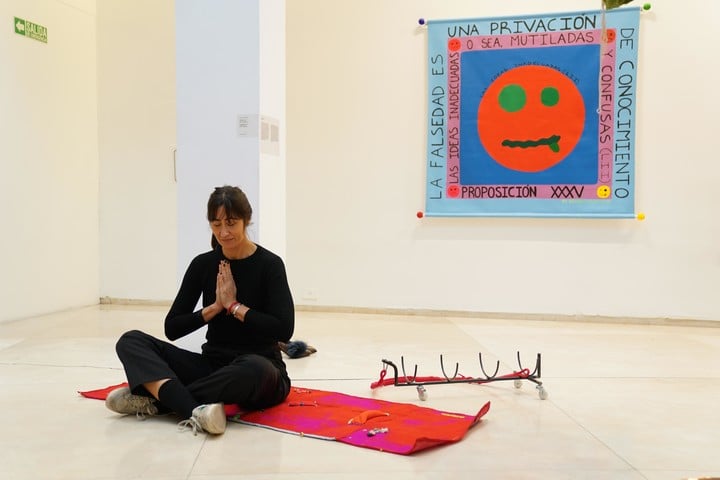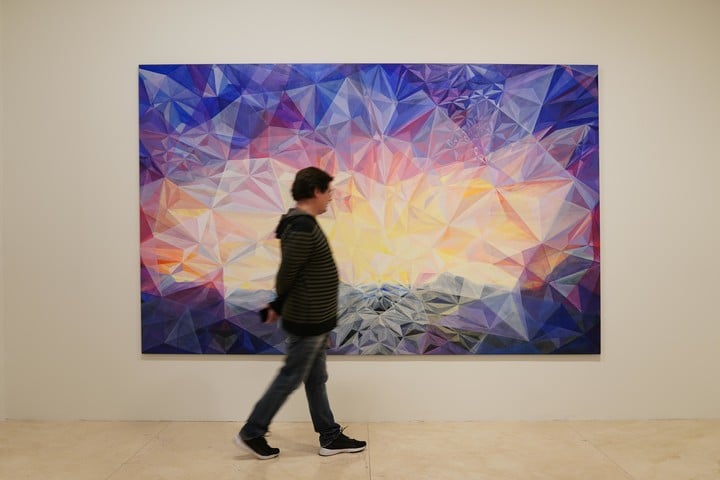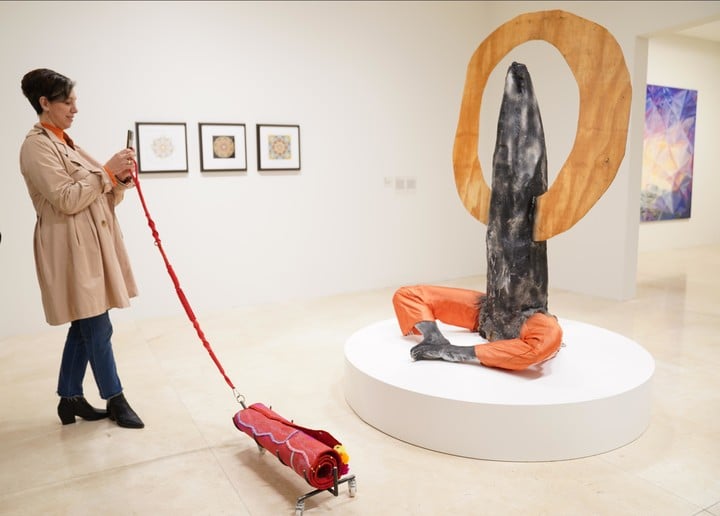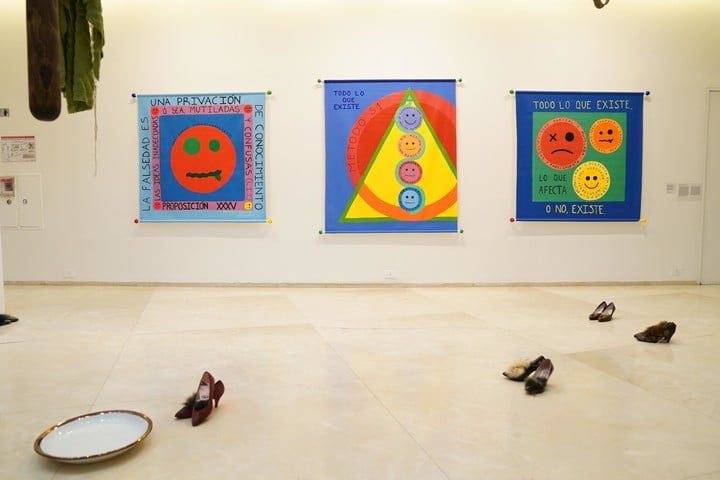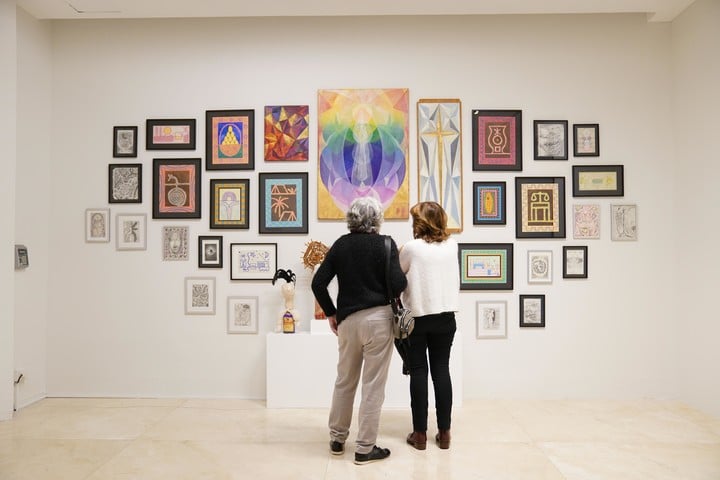in his book Man’s Search for Meaningthe Austrian philosopher Viktor Frankl (survivor of Auschwitz and Dachau) wrote that “life is not primarily a search for pleasure, as Freud believed, or a search for power, as Alfred Adler taught, but a search for meaning. Transcendence is part of that search for purpose.
The sample Light and forcewhich the Malba opens this Friday until November 13 on the ground floor of the Museum, connects with that search for transcendence, for encounter with meaning In a world where certainties have collapsed, climate change is devastating entire regions of the planet, and war tensions and pre-war threats threaten to reduce us to ashes.
Where to turn when praying is of no use to us? Where to look for answers? Is there possible protection? There art appears to open paths, although there are more questions along the way.
The exhibition curated by lara marble it is eclectic; his criteria is deliberately broad and he has sought to be inclusive.
To start, Light and force has a powerful connotation in this country due to the union that brings together electric power workers, that had strong names in its history. Just remember the trade unionist Agustín Tosco, one of the actors in Cordobazo in 1968, and Oscar Smith from Villa Domínico, who disappeared in 1977.
Marmor anticipates when referring to the guild at the beginning of his curatorial text. And he then describes the orientation of the exhibition: “It brings together artists whose works they explore the field of spirituality in a scenario with few certainties. Symptoms of deeper phenomena or simply part of a constellation that surrounds us, bioenergetics and coaching put psychoanalysis in a corner, tofu gains ground over bife de chorizo, and yoga competes with localized gymnastics. On bestseller lists, self-help books share space with mushroom encyclopedias and sophisticated astrological guides.
from that heterodox coexistence between followers of shamans, gurus and researchers who pay tribute to both Pachamama and Iemanjá, or explorers of ayahuasca (traditional Andean medicine or drug) and new cosmogonies, contemporary artistic materialities appear that both account for the emptiness of man in the world current, as of the multiple searches of purpose.
The curator wonders: “How does the overlapping of beliefs, practices and knowledge impact and constitute us? many times ancestral that make up that so elusive that we could call contemporary spirituality?
The question drives this exploration of artistic practice in the new millennium, when in an eclectic plot and sometimes contradictory, the ancient oriental and Amerindian worldviews coexist, meditation, holistic therapies, esotericisms, homeopathy, neo-shamanism, astrology or Buddhism”.
The bible and the water heater, without this sounding contemptuous or ironic. Because if it is true that art can and should be allowed to bring together works of contrasting diversity, under the heading of “new spiritualities”, not everything that is exhibited is literally of a spiritual nature.
The sample concentrates the works of almost 20 artists: Diego Bianchi, Paula Castro, Laura Códega, Roberta Di Paolo, Nicolás Dominguez Nacif, Bruno Dubner, Carlos Herrera, Daniel Leber, Martín Legón, Nicolás Mastracchio, Eduardo Navarro, Gastón Pérsico, Lucía Reissig and Bernando Zabalaga, Belén Romero Gunset, Marisa Rubio, Mariana Tellería , Ana Vogelfang and Ana Won.
Rituals, symbols and interpretations
At the beginning of the sample some giant birds receive the visitor. Between the physical and the spiritual, “Charly” Herrera revives his sculptures made of feathers, dried flowers, trunks, fabrics and explains that, for years, he has been working on the link with faith, with the body, with sexuality, with obsolete objects and a certain funeral air that his sculptural creations have. The son of a flower grower, Herrera used the ikebana technique to shape the pieces linked to physical loss according to the Catholic worldview.
under the birds there an installation with different pairs of women’s shoes, by Ana Vogelfang, with which the artist interprets a dream: if someone comes to take off the shoes of a living person, soon death will take him away. “The Talmud, in a section on the interpretation of dreams, says that dreaming of a dead person coming back to take off our shoes is bad news: our time has come. Just in case, let’s not use the shoes of a dead person…”, he says and everyone we smile discreetly. The artist began working on her works with her grandmother’s shoes and then progressed in search of “the soul of those objects.”
The painting dawnof great size, of Nicolas Dominguez Nacif fits a search for metaphysical meaning. The artist was trained in astrology, anthroposophy and other systems of ancestral and esoteric knowledge. It is true that it emerges from dawn a hypnotic attraction and perhaps this is due to the fact that the artist has worked with paints with plant dyes from jungles and forests, investigates theThe therapeutic properties of color and interprets symbols hidden by the western narrative.
The Tucuman artist Ana Won presents two recent, delicate and suggestive works, produced between 2022 and 2023: The brides and call his name to the night, in which different materials converge. They are loaded with religious symbolism, without necessarily being monotheistic.
Won understands her transformative practice, which brings her closer to alchemy. She meditates and then shapes entities where her formation as a Catholic and the worldview of the native culture of northwestern Argentina where she lives coexist.
We left behind vadaconasana, Diego Bianchi’s meditating totem, which the artist explains thus: “I liked the idea of contrasting something material and something spiritual, thinking of it as a yoga class in a context where a catastrophe was happening, with characters fighting with their bodies and their surroundings.” In this regard, he defined himself as prone to believe and disbelieve many things.
When referring to the chosen artists, the curator emphasizes in her text that in Argentina, the new age took its first steps hand in hand with the counterculture, gaining presence in the 90s and expanding in the following decade.
“The incorporation of habits traversed by discourses that celebrate self-awareness, healthy living and positivity enables a freer experience of desire and pleasure, in the antipodes of the weight that guilt, sin and sacrifice have in the traditional religions of West. The personal and social transformation, an issue that pivots between neoliberal individualism and the community associationism of the various activisms, takes on an unusual presence”.
The artists born between the 70s and the late 80s are largely the stars of this exhibition, says Marmor. “His childhood takes place in the passage from the dictatorship to the fervor of the Alfonsinista spring. Children of freedom, they live in the convertibility bubble during Menemism.
The positive, in any case, is that once the bubble burst, art began to explore new meanings. In many of the exhibited works The word God does not appear, but a connection with something that is beyond the narrow human matter is present. Several of the artists are meditators.
Mandalas, handicrafts and reproductions, as a technique and as a result, the entire exhibition leads to two artistic works to point out: a kind of altar that brings together small sculptures, paintings and drawings of Roberta Di Paolo, Laura Codega and Daniel Leber. It is a compilation of knowledge and forms of expression in tune with the tradition of popular saints but also with respect for nature.
The other set of pieces is very precious. Belonging to Mariana Telleria and it is already known. A series of eight mystical symbols from the series God believes in me that project a gesture of search for spirituality, a hidden story in what we see. When viewed together, the eight pieces seem to transform the meaning of each one separately.
We start with Viktor Frankl and it is worth remembering the Spanish philosopher Julián Marías, who exposes in human happiness, that it is necessary “to think about it in a concrete, imaginative way to understand what the human being is looking for when he affirms that he is looking for happiness.” Religious as he was, for Marías the search for happiness did not ignore transcendence.
The search for meaning and transcending the overwhelming day to day is the best synthesis of Light and force.
File
Light and force
Where: Malba, Figueroa Alcorta avenue 3415.
When: from Thursday to Monday, from 12 to 20; Wednesday, from 11 a.m. to 8 p.m. Tuesday, closed.
Entrance: $1,600 (overall).
pc
When praying is of no use to us: the Malba and a proposal on spirituality and art

